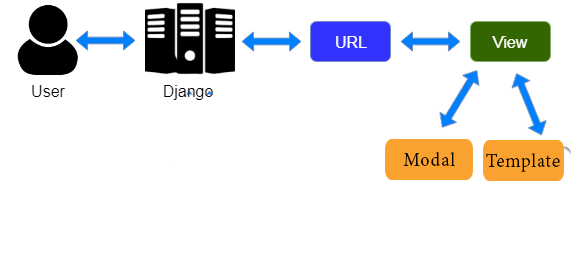Home >>Interview Questions >Django Interview Questions
Django Interview Questions
Django Interview Questions
1.Explain what is Django?
Django, written in Python, is a free and open source web application framework. It is a web framework on the server side, providing rapid development of secure and maintainable websites.
2.Mention the architecture of Django architecture?
Models: Describes your database schema and structure of your data .
Views: it controls what a user sees, retrieves data from suitable models and performs any calculation of the data and passes it to the template.
Templates: Depends on how the user uses it. It describes how to modify or format the data received from the views for display on the page.
3.How would you pronounce Django?
Django is pronounced JANG-oh. Here D is silent.
4.Which architectural pattern does Django follow?
Django follows architectural pattern of the Model-View-Template (MVT). See the graph below, showing the control flow based on the MVT.

A user requests a resource to the Django here, Django acts as a controller and checks the resource in URL available.
If URL maps are considered a view that interacts with model and template, then a template is rendered.
5.Is Django a low-level or high-level Web framework?
Django is the web framework of a high-level Python which was designed for rapid development and clean, realistic design.
6.What foundation manages the Web framework for Django?
Django web framework, non-profit organization called Django Software Foundation (DSF) manages and develops the Django software system. The primary objective of the foundation is the promotion, support and advancement of the Django Web framework.
7.What are the features available in Django web framework?
- Admin Interface (CRUD)
- Object-relational mapping (ORM)
- Testing Framework
- Internationalization
- Templating
- A Session, user management, role-based permissions
- Form handling
- Fantastic Documentation
8.Is Django stable?
Django is pretty stable, yes. Many companies have been using Django for many years, including Disqus, Instagram , Pinterest and Mozilla.
9.What are Django 's Disadvantages?
- The Django modules are bulky.
- It is basing entirely on Django ORM.
- Components are jointly deployed.
- To work with it you have to know the whole system.
10. What are Django 's Advantages?
- Django is an easy-to - learn python framework.
- It is straightforward and readable.
- It is powerful and versatile.
- Writing is quick.
- No loopholes in the design.
- It is safe.
- They 're scalable.
11. Is Django a framework for content-management (CMS)?
No, Django is not being a CMS. Rather, it's a Web framework and a programming tool that allows you to build websites.
12. What are the inheritance styles in Django?
- Abstract Base Classes: This style is used because you you use the parent class to contain details that you don't want to type out for and child model.
- Multi-table Inheritance: This style is used when subclassifying an existing model and ensuring that each model has its database table.
- Proxy models: This style is used when you just want to modify the model's Python level behaviour.
13. Which is the typical middleware use in Django?
- Cross-site request forgery protection
- Session management,
- Content Gzipping
- Use authentication
14. Why do you configure static files in Django?
- Set STATIC ROOT to the.py setting
- Run static collection for manage.py
- Set up a Static Files entry on the web tab PythonAnywhere
15. Which are Django's Signals?
Signals are code pieces that contain information about what's going on. A dispatcher sends the signals and responds to those signals.
16. What is Django Exception?
An exception is an abnormal event which results in program failure. Django uses its exception classes to deal with this condition and still accepts all main Python exceptions. Core exception classes for Django are defined in module django.core.exceptions.
17. What is Django Session?
A session is a process through which information is processed on the server side during the web application interaction. Session stores in the database by default, and also allows sessions based on file and cache.
18. How does Django handle URLs?
- The Django framework uses the module django.urls to handle URLs.
- Let's open the project's urls.py file, and see how it looks:
- See, Django has already mentioned an Admin URL here. The path function takes the first argument as a string or regex-type pathway.
- The view statement is a display feature that is used to return a user's answer (template).
19. What does Django-admin.py and manage.py allow for?
- Django-admin.py: It is an administrative function command line tool for Django.
- Manage.py: This is a file generated automatically in each Django project. It is a thin wrapper in the Django-admin.py environment. It does have the following uses:
- It puts the package of your project into sys.path.
- It sets the environment variable DJANGO SETTING MODULE to refer to the setting.py file for your project.
20. What are the two important signaling parameters?
- Receiver: Specifies the callback function that connects to the signal.
- Sender: Specifies a specific sender which receives a signal from.
21. Explain what makemessages command django-admin.py is used for?
This command line executes all of the current directory 's source tree and abstracts all the strings designated for the translation. It does a message file in the directory of the locale.
22. Mention what command line can be used to load data into Django?
You have to use the command line Django-admin.py loaddata to load data into Django. The command line must check the details and load into the database the contents of the called fixtures.
